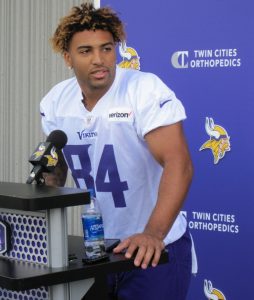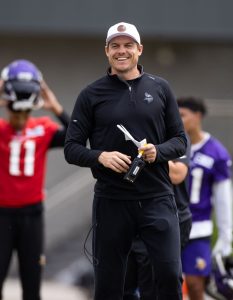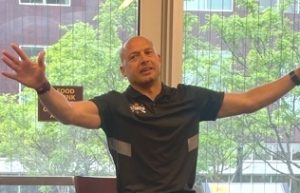Check the pulse of any pro football fan who isn’t eager to see Sunday’s Vikings-Packers game at U.S. Bank Stadium. For an opener this one has unusual intrigue and importance.
Start with the historic rivalry between the two franchises. Green Bay and Minnesota could both have 0-12 records and the matchup would have juice with players and fans. CBS has ranked it the No. 3 rivalry in the NFL of the 2000’s, and wherever it belongs there is no doubting the intensity past and present.
The Packers are all but a unanimous choice to win the NFC North Division, with the Vikings a favorite pick to finish second. Whoever wins Sunday will make an early statement about the division race.
“It’s really important for the Vikings,” a former NFL executive told Sports Headliners. “If they’re going to be threatening the Packers this year, they almost need to get a win. It’s the opener at home and it’s not going to be easy to win in Lambeau on New Year’s Day—let’s face it.”
The game will be the first for new Vikings head coach Kevin O’Connell and his staff. How they will perform is one of the game’s subplots. Another is both teams have unknowns regarding new players and veterans coming off injuries. A national TV audience, including a huge number of viewers in Minnesota and Wisconsin, will watch a game that will be broadcast by Fox in the coveted late afternoon time slot.
Here is analysis of the two teams including comments about offense, defense, special teams and coaching.
The Packers have the reining NFL MVP in quarterback Aaron Rodgers but the defense is also a happy topic in Green Bay. The unit’s standouts include corner Jaire Alexander, nose tackle Kenny Clark, and linebackers DeVondre Campbell, Rashan Gary and Quay Walker.
The Packers are expected to be one of the top defenses in the NFL. “I mean they are loaded on defense,” said the NFL authority.
The source, who asked that his name not be used, is cautious about predicting how the Vikings’ offense will matchup against the Packers because this will be O’Connell’s first game calling plays and the starters played minimally, if at all, in preseason. He did watch the regulars in joint practices against the 49ers (another top defense) and was impressed.

The offense will count on its established skill players and hoped for improved offensive line to do damage against the Packers. The quartet of quarterback Kirk Cousins (4-3-1 record against Green Bay), running back Dalvin Cook, and wide receivers Justin Jefferson and Adam Thielen is a group that NFL franchises envy. Tight end Irv Smith Jr., coming off an injury, is another valued receiver and is likely to play Sunday.
The offensive line might be the best in years. Brian O’Neill is a premier right tackle and second-year left tackle Christian Darrisaw impressed during training camp. Left guard Ezra Cleveland could be improved, too. Right guard Ed Ingram and center Garrett Bradbury are concerns. Ingram is a rookie and Bradbury, now in his fourth season, has struggled in the past including against Green Bay’s Clark.
The NFL authority said he’s not sold on Bradbury and it would be “huge” if Ingram can play well and help the veteran center. “We’ll see real quick about Bradbury in week one against Kenny Clark. He claims he put on 10 pounds. He’s trying to be stronger, anchor better, but he still had some trouble in training camp with Harrison Phillips who is a very good nose tackle.”
The source gives the edge to the Packer defense against Minnesota’s offense.
Regarding the Minnesota defense against the Packer offense, he isn’t discounting the loss of star wide receiver Davante Adams who was traded to the Raiders and the overall uncertainty of the Green Bay receiver group. Adding to the flux is that Adams’ successor, Allen Lazard, may not play Sunday because of injury.
There is also nail-biting in Green Bay about the availability of starting offensive linemen David Bakhtiari and Elgton Jenkins who are coming off of knee injuries. Their absence Sunday enhances the likelihood giftedVikings pass rushers Danielle Hunter and Za’Darius Smith may wreak havoc on Rodgers who this year could become the first ever to win NFL Player of the Year three consecutive seasons.
Outside linebackers Hunter and Smith have big upsides as pass rushers but also have histories of injuries. If healthy, Hunter and Smith can take a lot of pressure off the uncertain secondary that includes two inexperienced and vulnerable defenders, safety Camryn Bynum and corner Cam Dantzler. Rodgers and the Packers will likely take dead aim at Dantzler, a third-year defender, rather than 32-year-old veteran corner Patrick Peterson.
Expectations are Smith and Hunter can do a lot to improve a Vikings defense that gave up more passing yards than all but four other NFL teams in 2021. Only six teams gave up more rushing yards.
The defense may be improved but the Packers offense gets the nod over the Minnesota defense because of Rodgers. The 38-year-old quarterback still has a superb arm, accuracy and pocket presence that allows him to escape trouble. He ranks fifth all-time in touchdown passes and 10th in passing yards. His 109.7 passer rating in road games was the best in the NFL last season.
Coaches? Green Bay’s Matt LeFleur has yet to produce a Super Bowl team but winning 13 games each of his first years is impressive. Now he could become the first NFL head coach since 1970 to do it four consecutive seasons.
O’Connell, 37, has no track record as a head coach. “You have to give an advantage there in week one (to the Packers),” the source said.
O’Connell is an offensive-minded coach and that’s expected to benefit Cousins and the passing game. Since his hire early this year he has tried to make the team culture inclusive and comfortable for his players. Does that raise a question about whether he can discipline and control the locker room? “I think that’s going to be fine and I think they’re going to want to win for him,” the source said.
The Packers were knocked out of the playoffs last winter partially because of a blocked punt. Special teams was considered a team weakness and LaFleur has brought in a new coach (Rich Bisaccia) to direct that unit. Adding to the special teams uncertainty is veteran kicker Mason Crosby coming off of knee surgery and not playing in the preseason.
“I think the Vikings could have an advantage there with Greg Joseph who I think is coming off a good second half of last season,” the source said. “He had a really good camp. In preseason games he kicked a 58 yarder in Denver. So he’s got a lot of confidence.”
The Vikings’ special teams also feature kickoff returner Kene Nwangwu who had two returns for touchdowns last season. Recent acquisition Jalen Reagor is a hoped for upgrade in punt returning. Rookie punter Ryan Wright won the punting job from veteran incumbent Jordan Barry.
The NFL authority gives the edge to Minnesota’s special teams and sees another important factor in the Vikings’ favor. A frenzied crowd will provide the Vikings a home field advantage and make on-field communications challenging for the Packers.
Add everything up and it’s evident why this game, with the Packers favored by only about two points, could be a classic matchup of iconic franchises. “We know there’s a good chance that this game is going to come down to the very end,” O’Connell said.
Comments Welcome





